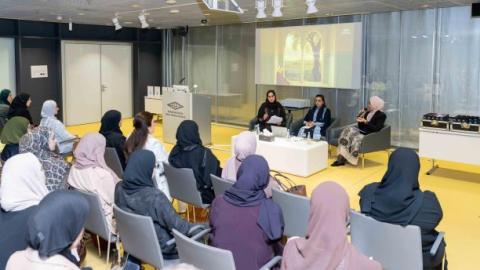
Qatar National Library hosts a first-of-its-kind online lecture to introduce non-destructive scientific techniques to analyze heritage materials. The event, “Scientific Applications for Preserving Islamic Documentary Heritage,” is part of the Library’s efforts to promote cultural and historical preservation as part of the Doha Capital of Culture for the Islamic World 2021 (DCCI).
The lecture was conducted by Maxim Nasra, Book Conservation Specialist at the Library, and explored the most important spectroscopic techniques for conducting non-destructive scientific analyses of heritage materials. The spectroscopic techniques introduced are considered critical knowledge for the examination, preservation and conservation of heritage materials. Nasra also showcased a few examples, offering attendees practical knowledge on the usage of these techniques.
Conducted in English, the lecture was aimed at specialists, students, researchers and those interested in the field of documentary heritage preservation. With nearly 130 attendees, the virtual event witnessed high participant engagement and curiosity.
Maxim Nasra, Book Conservation Specialist at the Library said, “In our role as an educational and cultural institution, we believe it is our responsibility to educate researchers, students and specialists on the latest technologies and techniques that can enhance the preservation and conservation of Islamic heritage items. Our primary focus was to showcase the benefits of spectroscopic techniques that can analyze heritage material without destroying them in any way.”
Nasra further added, “Learning these techniques will ensure the continuity of clarity of written texts, drawings and decorations. It will identify the causes of deterioration and thereby help us establish effective methods of treatment and conservation.”
The session highlighted microfading testing, a common technique used at the Library to understand the deterioration in the structure of materials while also determining the duration the material can be exhibited for without damaging it.
Technical photography is another scientific technique used to understand the pigment or dye used in the heritage item. Nasra demonstrated this technique using a 2nd-century AH / 9th-10th century CE Qur’anic page that the Library wants to preserve for future theoretical research. He also mentioned the use of other common types of spectroscopic techniques, such as Raman spectroscopy, Fourier transform infrared spectroscopy, x-ray fluorescence spectroscopy and reflectance spectroscopy.
The Library continues to offer a variety of virtual events in all subject areas that educate, engage and empower. To learn more about upcoming events, visit the Events page on the Library’s website (www.qnl.qa/en/events).







